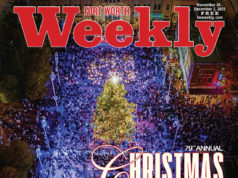Sharon Isbin plays at TCU this Saturday, courtesy of Fort Worth Classic Guitar Society (who, by the way, just announced a giveaway of free tickets to military personnel, volunteers, and first responders). She’s perhaps the finest classical guitarist in the world and also openly gay, and in recognition I thought I’d present a list of the best openly gay classical musicians.
Why is this important? In the case of opera singers (and there are many on this list), their jobs are similar to actors’, and audiences take an interest in their personal lives because those lives frequently shed light on the roles that those performers play. There are an increasing number of operas with gay subjects or gay characters, but even established works contain roles in which performers (usually female) are called on to play characters of the opposite gender. As for instrumentalists or conductors, well, I’m not aware of any gay way to play Beethoven’s piano sonatas or Mahler’s symphonies. However, openly gay people in any walk of life serve as an example, and acknowledging those who are out can encourage those who are still closeted. I’m not including gay and lesbian composers on this list, simply because there are too many of them. One day the same will hold true for performers like these.
Sharon Isbin
She deserves to be first here, since she came out to Out magazine all the way back in 1995. Few classical guitarists tend to penetrate the public consciousness, but Isbin has worked tirelessly on behalf of her instrument, commissioning new works, founding the guitar department at Juilliard, appearing on The L Word, and putting guitar lessons out on the web. To top it all off, she can strum the guitar like few others. Check out her tremolo technique on Francisco Tárrega’s Recuerdos de la Alhambra, a fiendishly difficult piece that sounds like two guitars playing at once.
Jean-Yves Thibaudet
Whaddya know? He’s in Dallas this weekend while Isbin is in Fort Worth. This French pianist is a huge opera fan, not a quality one finds too much among classical pianists, and he’s even performed onstage at the Met in a non-singing role. His pianism is clear, direct, and light, qualities that French pianists are known for. Here’s his recording of Debussy’s “La fille aux cheveux de lin” (“The Girl With the Flaxen Hair”), full of simplicity and jewel-like beauty.
Beth Clayton and Patricia Racette
It’s easy to group these two together, since they’re married to each other in real life. They both have local ties, too — soprano Racette is a UNT graduate, while mezzo-soprano Clayton sang Carmen with Fort Worth Opera two years ago to good reviews. Unfortunately, YouTube doesn’t have any video spotlighting Clayton’s singing, though it does have this video the couple made for the It Gets Better project. Racette’s voice has power, beauty, and a distinctive timbre that fits her for big, dramatic roles, whether in the Italian repertoire or more contemporary works. If you want to hear her in something traditional, here’s her “Un bel di vedremo” from Madama Butterfly, but I’ve embedded this piece of ravishing singing from Tobias Picker’s opera Emmeline.
Michael Tilson Thomas
This protégé of Leonard Bernstein has imitated his mentor in many ways: the undisguised sexuality, the flamboyant style on the podium, the choice of repertoire, and even the wild man behavior. (Thomas was busted for pot and cocaine possession at an airport in the late 1970s.) Some observers dismiss him as Bernstein lite, but he’s a music-maker of considerable substance, in addition to being the founder of the YouTube Symphony Orchestra. He conducts the first half of Carl Ruggles’ Sun-Treader in this clip (the second half is here), music that you can feel continents shifting under your feet as you listen.
Stephen Hough
A British pianist who brings rigor and musicianship to his performances of Liszt and Rachmaninov without sacrificing their fire and style, here he is playing the last movement of Rachmaninov’s Third Piano Concerto.
Marin Alsop
The first woman to be appointed as the music director of a major orchestra, namely the Baltimore Symphony Orchestra. She does program notes for that ensemble in the form of short films on the web. Here she is conducting Shostakovich’s jaunty Jazz Suite with her customary verve. This is just Part 1, the other parts are here and here.
Garrick Ohlsson
A large guy (6’4”, 260 pounds) with a muscular style at the piano that matches his frame. This excerpt from 1978 performance of Brahms’ Second Piano Concerto demonstrates that quality pretty well.
Brian Asawa and David Daniels
A countertenor is a male singer who sings in falsetto. As more Baroque Era operas originally written for castrato singers have been getting recorded, this highly specialized type of singer has been getting more opportunities. These two singers have been part of the wave of countertenors who’ve been able to take advantage. Countertenors are often pigeonholed into Baroque music, so I sought out non-Baroque stuff for these guys. Asawa’s unearthly voice takes on Rachmaninov’s “In the silent night,” while Daniels’ exquisite musicianship can be heard on Berlioz’ Les nuits d’été.
Brigitte Fassbaender
This mezzo made her name playing the “trouser roles” in various German operas, and did so in an effortless way that earned her a huge following among opera fans. This clip of her singing the male role of Prince Orlofsky in Johann Strauss’ Die Fledermaus not only gives you an idea of her musicality but also her commanding stage presence. The stage is her natural milieu; she’s now retired from singing and directing theater performances in her native Germany.
Earl Wild
I’m cheating here. I’ve confined my list to musicians who are still alive, but this pianist passed away last year and I feel guilty about not taking note of it on this blog. He wasn’t taken as seriously as he should have been because of his showhorse tendencies, but his late-life recordings showed him to be a fine interpreter of Beethoven and Chopin. I remember him, though, for stuff like this recording of Liszt’s Reminiscences of Don Juan, which my initial reaction to hearing was, “There’s no way a human could play like this!” Earl Wild could.
Van Cliburn
Oh, what the heck? If I’m wrong, I’ll apologize. Everyone knows his majestic 1958 performance of Tchaikovsky’s First Piano Concerto at the Tchaikovsky Competition, but I thought I’d embed his roiling performance of Rachmaninov’s Étude-tableau in E-flat minor. It’s faster than most pianists take it, but not too fast, and played with magnificent depth of sorrowful emotion.












Many thanks for this excellent article. I have added a link to it in both the news section and the coming out section of our website:
http://www.galyic.org.uk/support/c_o_advice.html
If you were going to take chances you might have included Leontyne Price [I know she is dead but she was such a great singer] who lived with the same woman for over 40 years. Too bad that African-American gays and lesbians still have to contend with such high levels of homophobia in the community.
She is NOT dead, you idiot!
Leontyne Price is definitely not dead — thank goodness. And long may she live, happy and healthy.